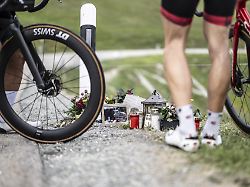Risk is part of the fascination
Tour de France “has become significantly more dangerous”
6/27/2023, 7:16 am
Before the start of the Tour de France, the discussions about the safety of the drivers are big. The death of the Swiss Gino Mäder at the Tour de Suisse overshadows the traditional cycling spectacle. But serious solutions are not in sight, criticizes former world champion Tony Martin.
Tony Martin no longer understands the world. Shortly before the Tour de France, the tragic death of Gino Mäder tore open a collective wound in cycling, although people seem to be all too happy to go round in circles when it comes to safety. “The way I see it, relatively little has happened. It feels like we’re still driving around with the same standard as at the start of my career. I tried to bring about a lot, but relatively little or nothing happened,” said the 38-year-old Martin, who ended his career in 2021.
The first week of the tour is often breakneck anyway and overshadowed by serious falls. Every professional is a bit more motivated, every team pushes a little more towards success. A stage win at the greatest spectacle in cycling can shape an entire career. And when the starting gun is fired in the Basque Country on Saturday, that means in the first two days above all: Lots of small roads, steep and winding descents – and everyone wants to be at the front. “But not everyone can drive at the front. That’s why the field is taking on a momentum of its own. Falls will probably be unavoidable,” said Ralph Denk, boss of the top German team Bora-hansgrohe.
It is a sporting dilemma for which there are only limited solutions. There is definitely potential for securing sections of the route better or planning stages better. This applies above all to town crossings, traffic islands, roundabouts or the design of the final of a stage. “Cycling without falls and serious injuries will not exist, but there are many countermeasures that can be taken,” said Martin. There have already been some minor changes there in recent years.
Departure to the finish as a danger
But something always had to happen first. Since the life-threatening fall of Dutchman Fabio Jakobsen at the 2020 Tour of Poland, special barriers have been set up in the sprint finals instead of simple barriers. The death of Mäder, who had an accident a week and a half ago at the Tour de Suisse on the descent from the Albula Pass, could hardly have been prevented. “It’s not possible to secure that to a standard, such as is the case in ski racing in Kitzbühel with triple safety nets,” said Denk. But that is exactly what is being discussed. In the future, at least certain sections of descents are to be secured by safety nets. It’s all – how could it be otherwise – a question of money.
The interface between drivers and organizers as well as the world association UCI is an old companion of Tony Martin. Adam Hansen is President of the Drivers’ Union CPA. On Wednesday he will sit down with the UCI, the teams and the tour organizer ASO. One topic: security. “We want to discuss what we can do about arrivals after departures,” Hansen told the Guardian. Mäder died during a stage designed in this way. There will be two sections of the tour in the high mountains, with a descent after the last pass.
There is rarely any argument other than spectacle for such a route planning. Apparently, there is speculation that drivers who are left behind on the mountain take an additional risk on the descent to make up time. Ralph Denk, however, argues that a little too simply: “If there is another mountain, the descent is hammered down just as well.” According to Hansen, the ASO is very open to security issues. However, it is very unlikely that tour stages will be changed at short notice.
Better training for drivers needed?
Hansen sees another approach to improving safety: educating drivers. “Maybe we need better training for the drivers,” said the 42-year-old. The professionals should be “very well informed about the risks”. One background is that the wheels are getting faster and faster due to technical developments. Three-digit speeds are no longer anything special for professionals on an alpine descent these days. “It has become significantly more dangerous,” said Hansen.
What – as macabre as that may sound – for a professional is simply to turn off the head “It has always been present that something can happen,” said the German champion Emanuel Buchmann. “I think you have to hide that a bit. Otherwise you can’t do the sport in the long run.”
